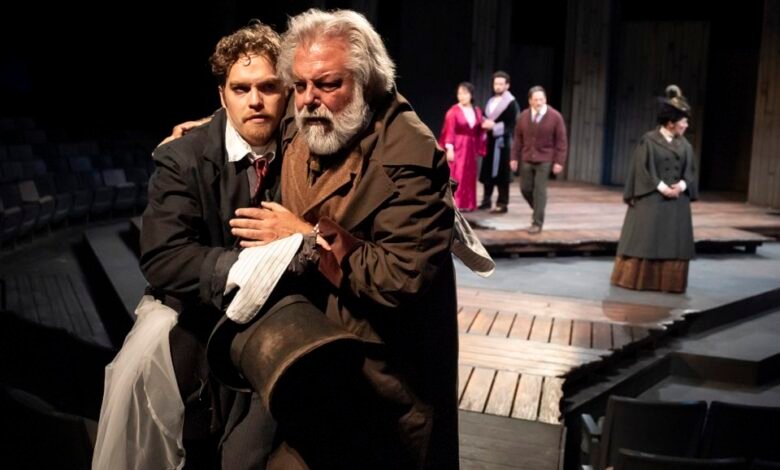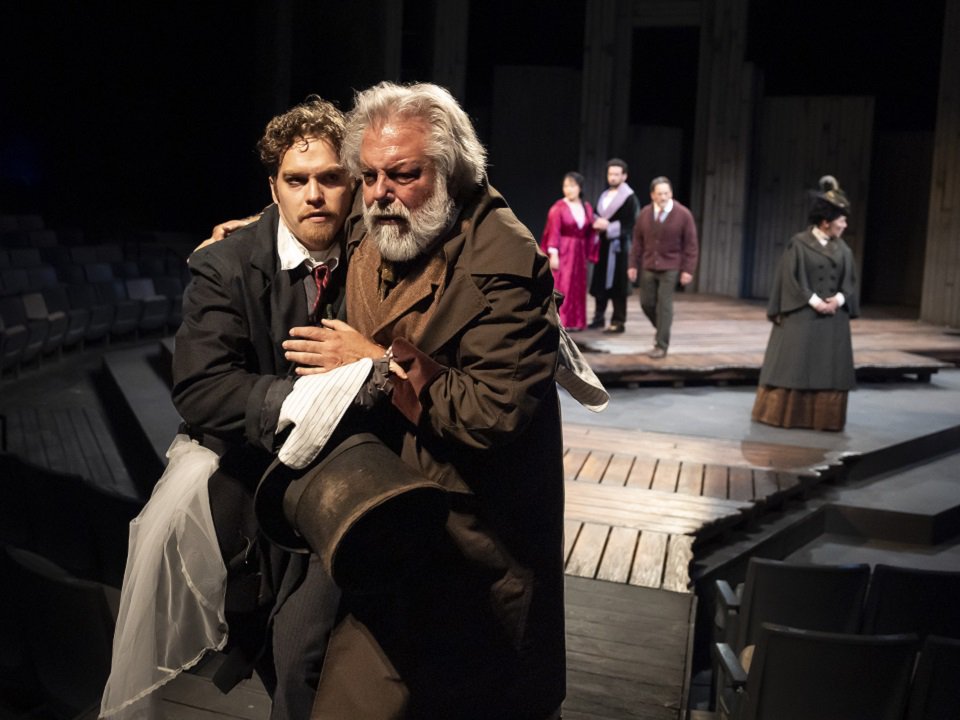Strong performances are at the heart of American Players Theatre’s ‘King Lear’. – Isthmus


King Lear is often considered Shakespeare’s greatest tragedy. Like Hamlet and Macbeth, the play ends with a heap of dead bodies, and like those plays asks the question: What makes a good ruler? Who should be king?
But Lear insistently poses more existential, philosophical questions: What is “natural”? Stripped of our roles in society, what are we?; what makes man more than “nothing”? That complexity, coupled with what is at times a messy plot, can make Lear a challenge. The good news is that American Players Theatre mostly rises to the challenge.
Aging King Lear (Brian Mani, in all his majesty), having no male heirs, decides to divide his kingdom among his three daughters. Who gets how much depends on her answer to his outright demand for flattery: Tell me how much you love me; winner gets the best land. It’s the big mistake that sets the plot in motion.
Daughters Goneril (Nancy Rodriguez) and Regan (Jessica Ko) tell Lear what he wants to hear. Youngest daughter Cordelia (Samantha Newcomb, in a businesslike, unsentimental performance) is measured, telling her father that she can say “nothing,” that she loves him according to her bond, as a daughter should. For her truth-telling she is married off, dowerless, to the king of France — effectively thrown out of the house.
Parallels to a certain contemporary political figure whose need for the continual propping up of his ego (and his retributive acts to members of his circle who don’t oblige) are obvious. But APT doesn’t underline the similarities, choosing a more traditional approach. Perhaps this is a wise decision; perhaps it’s a missed opportunity. It’s hard to say.
Mani is commanding as Lear, and can seem, despite his ruthless actions, rather a good sort. James DeVita as the Earl of Gloucester is personable, piercing, and as usual ably walks the line between serious drama and raunchy comedy, that Shakespearean push-and-pull that is one of the reasons people are still watching his plays 400-some years after they were written. Rasell Holt, as Gloucester’s scheming, illegitimate son, Edmund, and Nathan Barlow, as his legitimate son and heir, Edgar, are both excellent: Holt imperious, Barlow tender.
Finally, Josh Krause as Lear’s Fool gives an outstanding performance that clearly conveys Shakespeare’s wordplay and demonstrates why Lear keeps him around — not merely entertaining his king but providing perspective that the king can tolerate. Yet the Fool is no yes-man. Krause is a proper scene-stealer whose performance hits no false notes.
At first I found Holly Payne’s costume design perplexing — the dress seems vaguely but not strictly mid-19th century, for no reason that is echoed in the emphasis of the production. The oddest choices — that the servant Oswald seems to be on leave from a barbershop quartet, that Edgar first arrives onstage as if garbed for a soccer game, and that Gloucester looks like a stereotypical college professor — made me wonder if the costumes are geared toward depicting the character’s true or inner self. Therefore Oswald is somewhat unserious; Edgar an innocent; Gloucester the pedant who is not so wise. Cordelia appears in a bridal gown, as this is her intended role, bride to another man, to whom she will owe fealty. The costuming helps the audience keep track of who is who.
The bridal gown returns in the Fool’s costume, a motley assemblage accented by Cordelia’s veil, which he clutches throughout the play like a teddy bear. It’s often presumed that the roles of the Fool and Cordelia were played by the same boy actor in Shakespeare’s day (the two are never onstage at the same time, the Fool arriving as Cordelia leaves to be married to the king of France; and the Fool disappears entirely after Cordelia’s return in act IV). The pairing hints at a psychic connection between the two characters, who act as primary truth-tellers to Lear.
The play’s double plot — Lear’s unjust treatment of Cordelia amid her sisters’ scheming, and Gloucester’s unjust treatment of Edgar due to his brother Edmund’s scheming — is mostly sorted out, but as we reach acts IV and V the multitude of betrayals, faked notes and characters in disguise gets confusing. The production loses steam after Lear’s reconciliation with Cordelia in act IV. This is exacerbated by some late fight scenes that, perhaps due to the 19th century dress, are conducted awkwardly with short knives (and in the case of Edgar, a mallet) instead of the swords the script refers to.
In his program note, director Tim Ocel nods to director Peter Brook’s thoughts about the play, that it is a “poem designed to study the power and emptiness of nothing,” which is borne out in Brook’s stark, black and white film of the play from 1971. Brook, Ocel notes, gives Lear “a point of view.” Here the point of view is somewhat less bleak. Ocel’s Lear hones in on how humans need the reassurances of others — not flattery, not the “glib and oily” art of Goneril and Regan, but in the steadfast familial faith of Cordelia and Edgar. There is relief in how family matters are sorted out, even as they are, for better and for worse.


